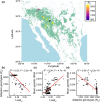Mutational load and adaptive variation are shaped by climate and species range dynamics in Vitis arizonica
- PMID: 40415570
- PMCID: PMC12177297
- DOI: 10.1111/nph.70238
Mutational load and adaptive variation are shaped by climate and species range dynamics in Vitis arizonica
Abstract
Genetic load can reduce fitness and hinder adaptation. While its genetic underpinnings are well established, the influence of environmental variation on genetic load is less well characterized, as is the relationship between genetic load and putatively adaptive genetic variation. This study examines the interplay among climate, species range dynamics, adaptive variation, and mutational load - a genomic measure of genetic load - in Vitis arizonica, a wild grape native to the American Southwest. We estimated mutational load and identified climate-associated adaptive genetic variants in 162 individuals across the species' range. Using a random forest model, we analyzed the relationship between mutational load, climate, and range shifts. Our findings linked mutational load to climatic variation, historical dispersion, and heterozygosity. Populations at the leading edge of range expansion harbored higher load and fewer putatively adaptive alleles associated with climate. Climate projections suggest that V. arizonica will expand its range by the end of the century, accompanied by a slight increase in mutational load at the population level. This study advances understanding of how environmental and geographic factors shape genetic load and adaptation, highlighting the need to integrate deleterious variation into broader models of species response to climate change.
La carga genética puede reducir la adecuación y limitar la adaptación. Aunque sus bases genéticas están bien establecidas, la influencia de la variación ambiental sobre la carga genética está menos caracterizada, así como la relación entre la carga genética y la variación genética potencialmente adaptativa. Este estudio examina la relación entre el clima, las dinámicas del rango de distribución de la especie, la variación adaptativa y la carga mutacional – una medida genómica de la carga genética— en Vitis arizonica, una uva silvestre nativa del suroeste de Estados Unidos. Estimamos la carga mutacional e identificamos variantes genéticas adaptativas asociadas al clima en 162 individuos colectados a lo largo del rango de distribución de la especie. Utilizando un modelo de Random Forest, analizamos la relación entre la carga mutacional, el clima y los cambios en el rango de distribución de la especie. Nuestros resultados mostraron una relación entre la carga mutacional, la variación climática, la dispersión de la especie y la heterocigosidad. Las poblaciones que se encontraron en el frente de la expansión del rango presentaron una mayor carga mutacional y menos alelos potencialmente adaptativos asociados al clima. Las proyecciones climáticas sugieren que Vitis arizonica expandirá su rango de distribución hacia finales de siglo, acompañado por un ligero aumento en la carga mutacional a nivel poblacional. Este estudio avanza en la comprensión de cómo los factores ambientales y geográficos afectan la carga genética y la adaptación, y resalta la necesidad de integrar la variación deletérea en modelos más amplios sobre la respuesta de las especies al cambio climático.
Keywords: adaptation; climate change; crop wild relatives; grapes; mutational load; species distribution models; species' range.
© 2025 The Author(s). New Phytologist © 2025 New Phytologist Foundation.
Conflict of interest statement
None declared.
Figures





Similar articles
-
Evolutionary Genomics Unravels the Responses and Adaptation to Climate Change in a Key Alpine Forest Tree Species.Mol Biol Evol. 2025 Jul 1;42(7):msaf116. doi: 10.1093/molbev/msaf116. Mol Biol Evol. 2025. PMID: 40415256 Free PMC article.
-
Genomic Insights Into Local Adaptation Across Heterogeneous Understory Habitats and Climate Change Vulnerability.Mol Ecol. 2025 Aug 18:e70068. doi: 10.1111/mec.70068. Online ahead of print. Mol Ecol. 2025. PMID: 40823727
-
Local adaptation has a role in reducing vulnerability to climate change in a widespread Amazonian forest lizard.Heredity (Edinb). 2025 Jun;134(6):352-361. doi: 10.1038/s41437-025-00765-x. Epub 2025 May 5. Heredity (Edinb). 2025. PMID: 40325155
-
A scoping review of tropical pioneer trees' roles for restoration and conservation management: Harungana madagascariensis (Hypericaceae) a widespread African species as a model.PeerJ. 2025 May 23;13:e19458. doi: 10.7717/peerj.19458. eCollection 2025. PeerJ. 2025. PMID: 40421372 Free PMC article.
-
Assessing the comparative effects of interventions in COPD: a tutorial on network meta-analysis for clinicians.Respir Res. 2024 Dec 21;25(1):438. doi: 10.1186/s12931-024-03056-x. Respir Res. 2024. PMID: 39709425 Free PMC article. Review.
References
-
- Aguirre‐Liguori JA, Ramírez‐Barahona S, Gaut BS. 2021. The evolutionary genomics of species' responses to climate change. Nature Ecology & Evolution 5: 1350–1360. - PubMed
-
- Aguirre‐Liguori JA, Tenaillon MI, Vázquez‐Lobo A, Gaut BS, Jaramillo‐Correa JP, Montes‐Hernandez S, Souza V, Eguiarte LE. 2017. Connecting genomic patterns of local adaptation and niche suitability in teosintes. Molecular Ecology 26: 4226–4240. - PubMed
-
- Angert AL, Bontrager MG, Ågren J. 2020. What do we really know about adaptation at range edges? Annual Review of Ecology, Evolution, and Systematics 51: 341–361.
MeSH terms
Grants and funding
LinkOut - more resources
Full Text Sources

